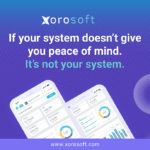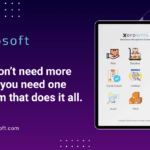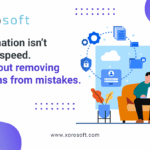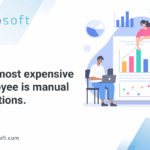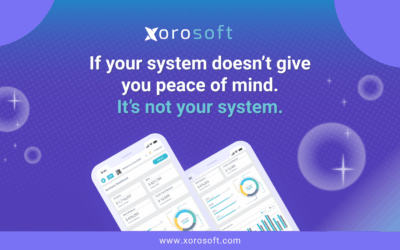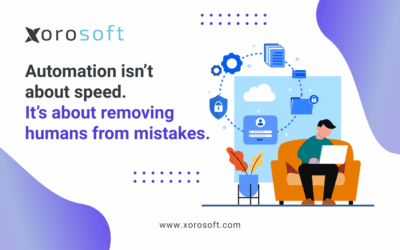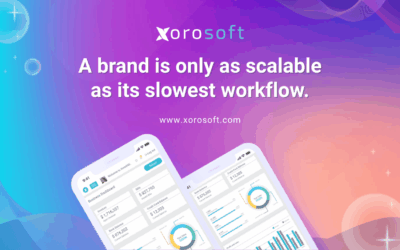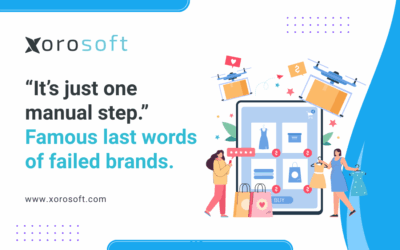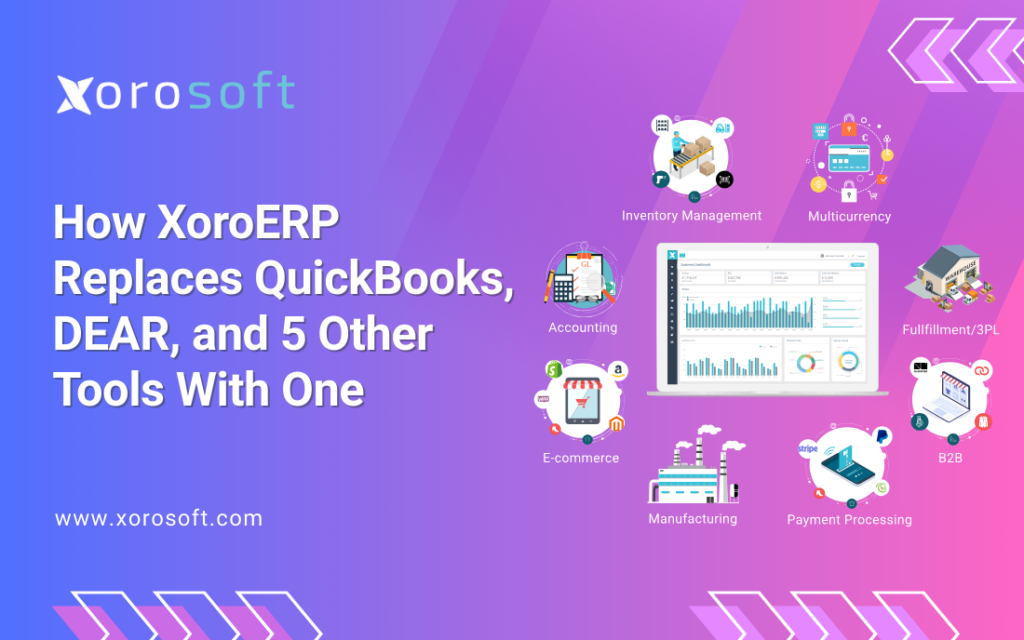
When growth exposes the cracks in your system
Scaling businesses often face a painful choice: juggle disconnected tools or unify everything under one ERP. This post examines XoroERP vs QuickBooks and DEAR, showing why XoroERP replaces them and five other apps with one powerful system.
At first, QuickBooks feels like the perfect starter for accounting. DEAR seems like a lightweight fix for inventory. Warehouse plug-ins, spreadsheets, and reporting tools plug gaps.
However, as demand rises, the cracks show. Finance struggles with reconciliations. Operations wrestle with duplicate SKUs across different systems. Customer service apologizes for orders canceled due to stockouts.
Executives, meanwhile, are left making high-stakes decisions based on outdated exports.
This is the hidden price of fragmented tools: chaos that scales faster than the business itself.
Why XoroERP vs QuickBooks and DEAR Shows the Difference
No leader sets out to build chaos. QuickBooks, DEAR, and Shopify plug-ins are adopted because they’re affordable and quick to set up.
Yet as growth accelerates, what worked yesterday creates bottlenecks today. And in the battle of XoroERP vs QuickBooks and DEAR, the cracks widen.
-
QuickBooks: Excellent for small-business accounting, but weak on multi-location inventory, consolidated reporting, and multi-currency operations.
-
DEAR Systems: Offers inventory features, but relies on clunky integrations and manual workarounds.
-
Warehouse apps: Run in isolation, leaving procurement and finance blind to inventory.
-
Reporting tools: Fail to deliver insights when every dataset lives in a different silo.
As a result, a simple purchase order requires five tools, three email chains, and too much human effort.
And when things break? There’s no single source of truth to pinpoint the issue.
Why XoroERP vs QuickBooks and DEAR Is No Contest
QuickBooks and DEAR aren’t bad products. However, they weren’t designed to power a multi-channel, multi-warehouse operation.
-
Disconnected by design: Each solves one problem but doesn’t integrate seamlessly.
-
No real-time visibility: Finance sees data long after it’s relevant.
-
Costly to maintain: Stitching tools together requires expensive APIs or IT resources.
-
Limited scalability: Adding channels, currencies, or warehouses pushes them beyond their limits.
Therefore, the real choice is clear: keep patching small tools or move to an ERP built for scale.
Why Businesses Are Choosing Unified ERP Over Patchwork Apps
At some point, duct-taping tools becomes a bigger risk than replacing them. Leaders realize what they truly need is a unified ERP system that manages finance, inventory, procurement, and fulfillment in real time.
ERP used to mean high costs, long deployments, and rigid processes. But cloud-native platforms like XoroERP change the equation.
-
One source of truth: Finance, operations, and fulfillment work from shared real-time data.
-
Instant updates: No more delays waiting for syncs or exports.
-
Scalable by design: Adding new sales channels or warehouses doesn’t take six months.
-
Alignment across teams: With one dataset, finger-pointing disappears and collaboration improves.
This isn’t just technology. It’s a mindset shift—from managing chaos to scaling with clarity.
How XoroERP Outperforms QuickBooks and DEAR
Here’s how XoroERP goes beyond patchwork tools and unifies your operations:
📊 Accounting and Finance (Replacing QuickBooks)
QuickBooks struggles with consolidations, manufacturing costs, and multi-currency. XoroERP does all of it natively.
Therefore, CFOs see real-time numbers tied directly to sales, inventory, and procurement. No exports required.
👉 Explore XoroERP Features.
📦 Inventory and Procurement (Beyond DEAR)
Unlike DEAR, XoroERP includes a robust built-in WMS. That means real-time tracking across multiple locations, vendor management, and automated purchase orders.
In addition, stock alerts prevent costly outages before they happen.
👉 See how it helps in Case Studies.
🚚 Warehouse and Fulfillment (No More Plug-Ins)
XoroERP centralizes fulfillment. Shopify, Amazon, and wholesale orders flow directly into the WMS with automated pick, pack, and ship workflows.
As a result, customers receive faster and more accurate deliveries.
👉 Available on the Shopify App Store.
🔄 End-to-End Automation
Invoices, reorders, reconciliations—automated across departments. Teams focus on strategy instead of repetitive admin.
📈 Real-Time Reporting and Analytics
Unlike QuickBooks or DEAR, XoroERP has built-in analytics. Reports are live, customizable, and always up-to-date.
🌍 Built for Multi-Location, Multi-Channel, Multi-Currency
Growth often means complexity. XoroERP thrives in complex environments, handling international suppliers, multiple channels, and global currencies with ease.
And it’s not just theory. XoroERP is ranked #1 in Ease of Use on G2 for ERP systems (see rankings here).
When Companies Decide to Switch From QuickBooks and DEAR
The breaking point often comes when growth stalls—not due to demand, but because the business can’t keep up internally.
-
Inventory errors create stockouts that cut into revenue.
-
Accounting delays result in poor decisions.
-
Teams waste hours reconciling disconnected tools.
Finally, leaders realize it’s not simply XoroERP vs QuickBooks and DEAR. It’s clarity versus chaos.
And because XoroERP deploys in weeks, not months, the decision feels obvious.
👉 Compare options on our Pricing page.
Growth Without Fragmentation
Businesses that switch to XoroERP no longer fight with a broken stack. Instead, they run finance, inventory, procurement, and fulfillment from a single ERP.
That means no QuickBooks. No DEAR. And no juggling seven different apps.
Growth doesn’t have to feel chaotic. With XoroERP, it feels aligned.
👉 Book a Demo and see what clarity looks like.
